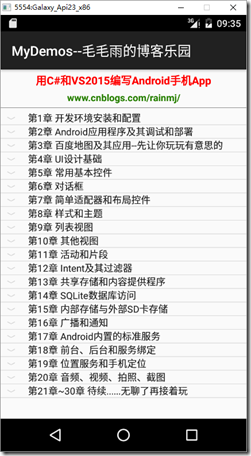編輯:關於android開發
Loop,Message,MessageQueue概念理解:
Message:Handler發送、接收和處理的消息對象
Looper:每個線程只能擁有一個Looper.它的looper()方法負責循環讀取MessageQueue中的消息並將讀取到的消息交給發送該消息的handler進行處理。MessageQueue:消息隊列,它采用先進先出的方式來管理Message。程序在創建Looper對象時,會在它的構造器中創建MessageQueue
Looper提供的源碼如下:
private Looper(boolean quitAllowed) {
mQueue = new MessageQueue(quitAllowed);
mThread = Thread.currentThread();
}
Handler:前面說Handler作用有兩個---發送消息和處理消息,Handler發送的消息必須被送到指定的MessageQueue,也就是說,要想Handler正常工作必須在當前線程中有一個MessageQueue,否則消息沒法保存。而MessageQueue是由Looper負責管理的,因此要想Handler正常工作,必須在當前線程中有一個Looper對象,這裡分為兩種情況:
1>主線程(UI線程),系統已經初始化了一個Looper對象,因此程序直接創建Handler即可
2>程序員自己創建的子線程,這時,程序員必須創建一個Looper對象,並啟動它。
創建Looper:使用Looper.prepare(),查看源碼
public static void prepare() {
prepare(true);
}
private static void prepare(boolean quitAllowed) {
if (sThreadLocal.get() != null) {
throw new RuntimeException("Only one Looper may be created per thread");
}
sThreadLocal.set(new Looper(quitAllowed));
}
private Looper(boolean quitAllowed) {
mQueue = new MessageQueue(quitAllowed);
mThread = Thread.currentThread();
}
通過方法調用,第9行創建Looper對象,創建Looper對象時同時會創建MessageQueue對象(第13行)。此外,可以看出prepare()允許一個線程最多有一個Looper被創建
啟動Looper:Looper.loop(),loop()使用一個死循環不斷取出MessageQueue中的消息,並將消息發送給對應的Handler進行處理。下面是Looper類中looper()方法的部分源碼
for (;;) {
Message msg = queue.next(); // might block
if (msg == null) {
// No message indicates that the message queue is quitting.
return;
}
// This must be in a local variable, in case a UI event sets the logger
Printer logging = me.mLogging;
if (logging != null) {
logging.println(">>>>> Dispatching to " + msg.target + " " +
msg.callback + ": " + msg.what);
}
msg.target.dispatchMessage(msg);
if (logging != null) {
logging.println("<<<<< Finished to " + msg.target + " " + msg.callback);
}
// Make sure that during the course of dispatching the
// identity of the thread wasn't corrupted.
final long newIdent = Binder.clearCallingIdentity();
if (ident != newIdent) {
Log.wtf(TAG, "Thread identity changed from 0x"
+ Long.toHexString(ident) + " to 0x"
+ Long.toHexString(newIdent) + " while dispatching to "
+ msg.target.getClass().getName() + " "
+ msg.callback + " what=" + msg.what);
}
msg.recycleUnchecked();
}
很明顯第1行用了一個死循環,第2行從queue中取出Message,第15行通過dispatchMessage(Message msg)方法將消息發送給Handler。
Looper,MessageQueue,Handler的各自作用如下:
Looper:每個線程只有一個Looper,他負責管理MessageQueue,會不斷的從MessageQueue中取出消息,將消息交給對應的Handler處理
MessageQueue:由Looper負責管理,是用來存放線程放入的消息。
Handler:它把消息發送給Looper管理的MessageQueue,並負責處理Looper分給它的消息
在線程中Handler的使用步驟是:
(1)調用 Looper的prepare()方法為當前線程創建Looper對象,創建Looper對象時,它的構造器會創建與之配套的MessageQueue。
(2)有了Looper之後,創建Handler子類的實例,重寫HandlerMessage()方法,該方法負責處理來自其它線程的消息。
(3)調用Looper的loop()方法啟動Looper。
 硅谷新聞6--下拉刷新/上拉加載更多,硅谷6--
硅谷新聞6--下拉刷新/上拉加載更多,硅谷6--
硅谷新聞6--下拉刷新/上拉加載更多,硅谷6-- 1.添加加載更多布局 1_初始化和隱藏代碼在RefreshListView構造方法中調用 private v
 【Android】以後改為在Win10下開發了,androidwin10
【Android】以後改為在Win10下開發了,androidwin10
【Android】以後改為在Win10下開發了,androidwin10分類:C#、Android、VS2015; 創建日期:2016-02-12 修改日期:2016-0
 [android]Android中圖形圖片及處理相關Api的小總結
[android]Android中圖形圖片及處理相關Api的小總結
[android]Android中圖形圖片及處理相關Api的小總結 開發應用中圖片的使用是必不可少的,Android系統提供了豐富的圖片支持功能。我們除了可以使Drawa
 完整項目:木子記事本(原創,轉載請注明出處)。,轉載出處
完整項目:木子記事本(原創,轉載請注明出處)。,轉載出處
完整項目:木子記事本(原創,轉載請注明出處)。,轉載出處 一個較為完整的記事本App,記錄,存儲到數據庫,編輯,保存。 運行效果圖: Activity類: